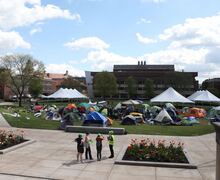City : A safe shot: City decides to install cameras in area with high number of shootings
The Syracuse Common Council approved the installation of nine security cameras in the city’s Near Westside on Nov. 22 after the topic was held on the council’s agenda for more than two months.
‘I think they wanted to evaluate the options here with what the public has to say, figure out the facts with crime statistics and cover all their bases,’ said Syracuse Police Department spokesman Sgt. Gary Bulinski on why the Common Council waited as long as it did to pass the proposal.
Some of the factors that contributed to the passage included the heightened amount of crime in the city during the past several weeks and a survey conducted of Near Westside residents that declared 96 percent of residents would support the use of cameras as a tool for the police department, Bulinski said.
SPD first asked the Common Council to use $125,000 in federal grant money to purchase and install nine cameras throughout the Near Westside at the council’s Sept. 23 meeting.
It will probably take three months to buy and install the nine cameras in areas selected for having the most shots fired, Bulinski said.
Between Jan. 1 and Nov. 12, there were 241 shell casings recovered in the Near Westside, according to a crime map released by the Onondaga Crime Analysis Center on Nov. 17. Bulinski said this suggests multiple shooting incidents and a heightened security threat.
Rich Puchalski, executive director of Syracuse United Neighbors, said the increased violence has sent a shiver down the Near Westside’s spine. Puchalski’s organization gathers residents from the Near Westside to discuss the area’s problems.
‘Sometimes residents talk about, ‘Oh, we got another round of shootings over the weekend. They happened at night, and I can’t tell where they’re coming from,” he said. ‘They’re scurrying the kids in the bathroom and hoping the bullet doesn’t land inside the house.’
Twenty-three percent of the shots fired this year in Syracuse come from the Near Westside, Puchalski said.
In response to the violence and the proposal for the cameras, Puchalski and members of Syracuse United Neighbors wrote a petition supporting the cameras and the potential good they could do in the community. City Clerk John Copanas said the petition received around 375 signatures from residents and their family members when he saw the letter before the Nov. 22 Common Council meeting.
Members of Syracuse United Neighbors also made multiple calls to the councilors about the security cameras, Puchalski said. He said his organization probably made a large impact on the councilors’ decisions.
Several calls to Common Councilor William Ryan, chair of the city’s Public Safety Committee, and other counselors on the committee were not returned for this story.
SPD officers went door-to-door to residents in the Near Westside and conducted six-question surveys. Some of the questions asked ‘In general, how safe do you feel in the area?’ and ‘Do you think the cameras will make you feel safer in your home?’
Out of the 260 residencies the officers stopped at, people in approximately 210 of the homes answered the survey, according to the survey document. Overall, results from the survey supported the use of the cameras.
Cameras are nothing new to solving crimes in Syracuse. Stores and banks around the city have cameras for security purposes.
‘Everywhere you go, there are cameras,’ Bulinski said. ‘If you go to the airport, there are cameras. If you go to the mall, there are cameras.’
As for the future of camera surveillance in Syracuse, Bulinski said it can only go up. SPD also accepted an $84,400 state grant to install five more cameras in the city’s Southside, but the proposal still needs to go through the Common Council for approval.
The document from the Onondaga Crime Analysis Center cited several crimes that had been solved or aided by camera footage.
‘In one situation when a gentleman was killed, a camera in the corner store was used to apprehend the individual,’ Puchalski said. ‘It was put on TV.’
But the cameras that have already been approved for installation have some drawbacks, Puchalski said. Each camera will be fairly stationary on a pole, as it cannot move 360 degrees around. The cameras also do not have any audio settings.
Despite the shortcomings, the cameras will allow another set of eyes in the city to look out for crime.
‘If you’re a law-abiding citizen, there shouldn’t be an issue,’ Bulinski said. ‘If you’re someone that’s looking to commit a crime, this is how we can see that.’
Published on December 1, 2010 at 12:00 pm




